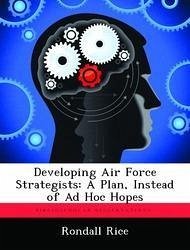The current demand in the Department of Defense (DoD) for better strategists and better strategic planning is not new, yet the United States Air Force (USAF) has not taken concrete steps to ensure that it develops and sustains a cadre of strategy specialists. In the face of diverse and rapidly-emerging threats in an age of globalization, the United States and the U.S. Air Force no longer have the luxury of talented strategists emerging by happenstance from outdated personnel development systems. To truly develop strategists--and have them stay in uniform and serve at the most senior ranks--the USAF must commit to a cultural change regarding how it views the career path to senior leadership. The service must implement a strategist career specialty with deliberately planned and tracked career development programs. I propose a two track system, the Command Strategist and the Professional Strategist. Both of these Air Force strategy officer tracks begin with selection at the senior captain level and both use top civilian universities to educate the officers in war studies or strategy-related programs. Both tracks require an assignment teaching in the military system, and alternate with assignments in strategist billets at Combatant Commands and higher staffs. For such a system to work, the service leaders must change how they view promotion, promotion prerequisites (especially the value of traditional command, in the case of the Professional Strategist Officer), and create and allow for the unique--but highly qualified--strategist path.








